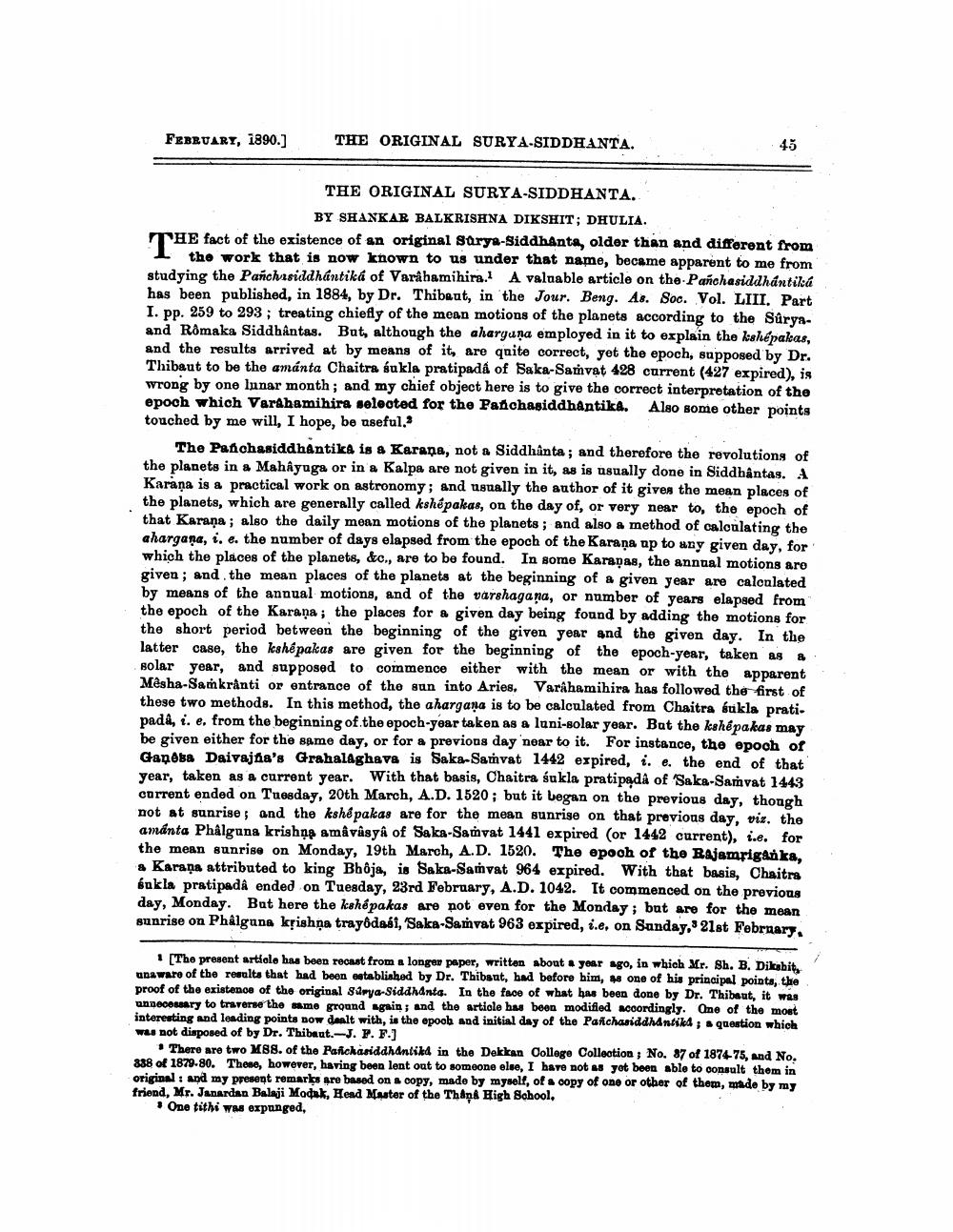________________
FEBRUARY, 1890.)
THE ORIGINAL SURYA-SIDDHANTA.
45
THE ORIGINAL SURYA-SIDDHANTA.
BY SHANKAR BALKRISHNA DIKSHIT; DHULIA THE fact of the existence of an original Surya-Siddhanta, older than and different from
1 the work that is now known to us under that name, became apparent to me from studying the Pañohasiddhantika of Varahamihira. A valuable article on the Panohasiddhantiká has been published, in 1884, by Dr. Thibaut, in the Jour. Beng. As. Soc. Vol. LIII. Part I. pp. 259 to 293; treating chiefly of the mean motions of the planets according to the Süryaand Rômaka Siddhantas. But, althongh the aharguņa employed in it to explain the kshé pakas, and the results arrived at by means of it, are quite correct, yet the epoch, supposed by Dr. Thibaut to be the amánta Chaitra sukla pratipadå of Saka-Samvat 428 current (427 expired), is wrong by one lunar month; and my chief object here is to give the correct interpretation of the epoch which Varahamihira selected for the Panchasiddhantika. Also some other points touched by me will, I hope, be useful."
The Panchasiddhantika is a Karana, not a Siddhanta; and therefore the revolutions of the planets in a Mahayuga or in a Kalpa are not given in it, as is usually done in Siddhantas. A Karaṇa is a practical work on astronomy; and usually the author of it gives the mean places of the planets, which are generally called kshépakas, on the day of, or very near to, the epoch of that Karana; also the daily mean motions of the planets; and also a method of calculating the ahargana, i. e. the number of days elapsed from the epoch of the Karaņa np to any given day, for which the places of the planets, &c., are to be found. In some Karanas, the annual motions are given ; and the mean places of the planets at the beginning of a given year are calonlated by means of the annual motions, and of the varshagana, or number of years elapsed from the epoch of the Karana; the places for a given day being found by adding the motions for the short period between the beginning of the given year and the given day. In the latter case, the keshépakas are given for the beginning of the epoch-year, taken as & solar year, and supposed to commence either with the mean or with the apparent Mêsha-Sankranti or entrance of the sun into Aries. Varahamihira has followed the first of these two methods. In this method, the ahargana is to be calculated from Chaitra stikla prati. padd, i. e. from the beginning of the epoch-year taken as a luni-solar year. But the kshépakas may be given either for the same day, or for a previons day near to it. For instance, the epoch of Ganska Daivaja's Grahalaghava is Saka-Samvat 1442 expired, i.e. the end of that year, taken as a current year. With that basis, Chaitra sukla pratipądå of Saka-Samvat 1443 corrent ended on Tuesday, 20th March, A.D. 1520; but it began on the previous day, though not at sunrise, and the kshé pakas are for the mean sunrise on that previous day, viz. the amánta Phâlguna krishnş amâvâsya of Saka-Samvat 1441 expired (or 1442 current), i.e. for the mean sunrise on Monday, 19th March, A.D. 1520. The epoch of the Rajamriganka,
Karana attributed to king Bhoja, is Saka-Samvat 964 expired. With that basis, Chaitra bukla pratipadA ended on Tuesday, 23rd February, A.D. 1042. It commenced on the previous day, Monday. But here the kshấpakas are not even for the Monday; but are for the mean sunrise on Phålguna krishna tray@dasi, Saka-Samvat 963 expired, i.e, on Sanday, 21st February
· [The present article has been recast from a longer paper, written about a year ago, in which Mr. Sh. B. Dikabit, unaware of the results that had been established by Dr. Thibaut, bad before him, one of his principal points, the proof of the existence of the original Sirya-Siddhanta. In the face of what has been done by Dr. Thibaut, it was anDecossary to traverse the same ground again; and the article has been modified accordingly. One of the most interesting and leading points now dealt with, is the epooh and initial day of the Pafchasiddhantika; question which was not disposed of by Dr. Thibaut.-J. P. F.)
There are two 88. of the Parichasiddhantikd in the Dekkan College Collection ; No. 87 of 1874-75, and No. 838 of 1879-80. These, however, having been lent out to someone else, I have not as yet been able to consult them in original and my present remarks are based on a copy, made by myself, of a copy of one or other of them, made by my friend, Mr. Janardan Balaji Modak, Head Master of the Thiņå High School,
* One tithi was expunged,




